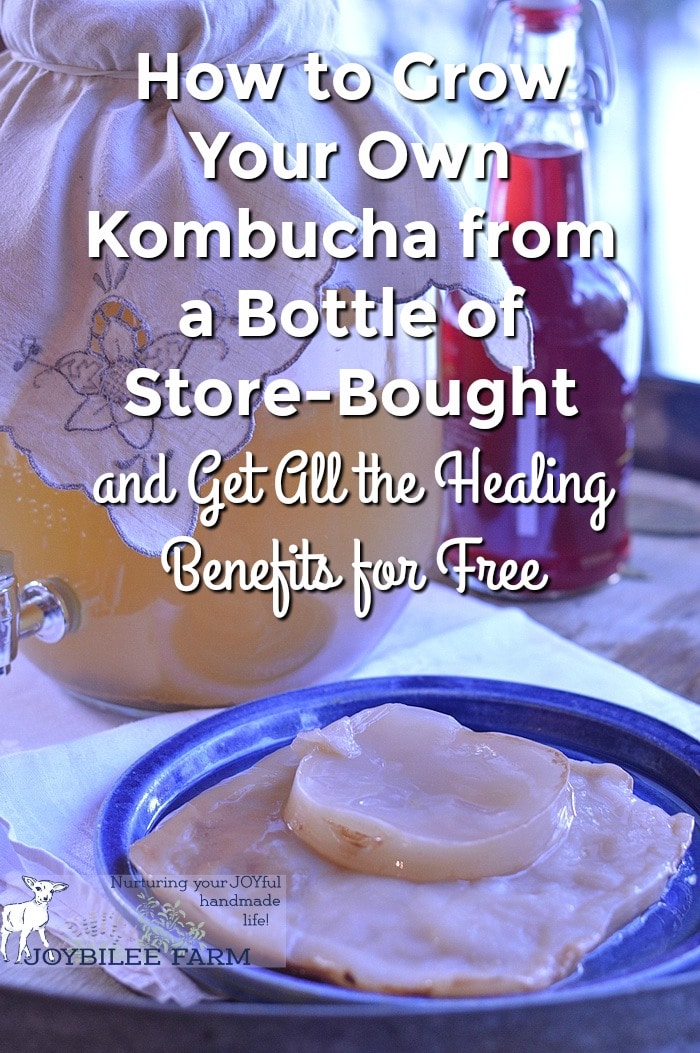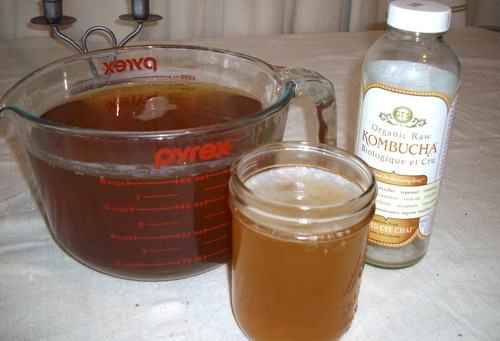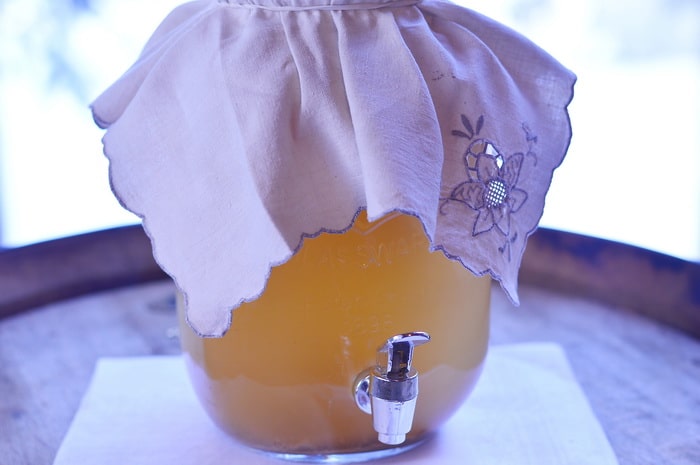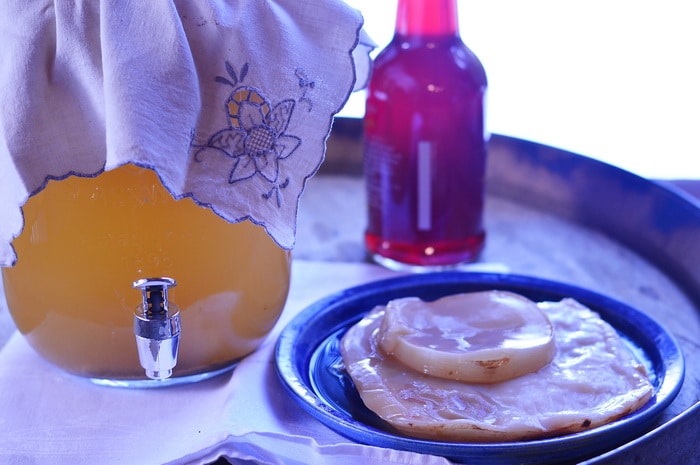Avoid the high cost of commercially brewed kombucha by brewing your own. It is simple, fun, and easy to make this delicious health drink for pennies, and very little time investment. Enjoy the health benefits of kombucha in abundance with this simple starting method.
Kombucha is simply a specially fermented tea drink. It is slightly sour, but pleasant tasting, made from a specific blend of bacteria that thrives in an acidic environment. Like sourdough or kefir, kombucha needs to be fed regularly to thrive. But the feeding is simple: just tea and sugar. The health benefits of kombucha far outweigh the effort to keep a kombucha mushroom alive. With one tablespoon of tea and 1/2 cup of sugar you can make 1/2 gallon of probiotic rich, healing kombucha, the equivalent of 8 bottles of store bought kombucha. Plus you can successfully repeat this every week for the rest of your life.
You’ll have enough of this healing elixir for your own family and for all your friends forever. You can begin today with a single bottle of store bought kombucha and this article, and soon be getting all the benefits of kombucha. Let’s get started!
The secret healing power of Kombucha

I first learned about the benefits of kombucha in Sally Fallon’s Nourishing Traditions (p.573). Kombucha tea, mushroom tea, or tea kvass is a fermented drink made from black tea and sugar. Although other teas can be used instead of black, Kombucha is traditionally made from black tea. Kombucha tea is a traditional natural remedy and health tonic used in China, Japan, Indonesia, Russia, Bulgaria, Poland, and Germany, as well as other countries. Kombucha benefits are off the map! If you add only one fermented food to your diet this year, you will want to add Kombucha tea, when you read about all the benefits of Kombucha for health, well being, vitality, and energy.
Benefits of Kombucha
Kombucha, according to Sally Fallon, is more than a drink. The benefits of kombucha are absolutely amazing! It’s a super star natural remedy for vibrant energy and health. This tonic provides not just beneficial lactic acid, enzymes, and probiotics to the human body, but also a “potent detoxifying substance, glucuronic acid.”
Normally this organic acid is produced by the liver in sufficient quantities to neutralize toxins in the body — whether they are naturally produced toxins or poisons ingested in food and water. However, when liver function becomes overloaded, and when the body must deal with a superabundance of toxins from the environment…additional glucuronic acid, taken in the form of kombucha, is a powerful aid to the body’s natural cleansing process, a boost to the immune system and a proven prophylactic against cancer and other degenerative diseases. (Fallon, 574)
I heard that President Ronald Reagan drank Kombucha tea regularly to recover from stomach cancer. Tom Valentine in Search for Health, mentions that areas in Russia where tea kvass (kombucha) is a regular part of the diet, cases of cancer are rare, although those regions have the same toxic exposure to heavy metals and radiation as the rest of the country. According to Les Aliments Fermentes Traditionnels, kombucha also possesses antibiotic properties. That’s a pretty impressive lists for the benefits of kombucha.
Tom Valentine in Search for Health says:
Glucuronic acid is not readily commercially synthesized, but the healthy human liver makes large amounts of it to detoxify the body. In the liver the glucuronic acid binds up all poisons and toxins– both environmental and metabolic — and rushes them to the excretory system. Toxin once bound by glucuronic acid cannot be resorbed into the system so we are rid of them.
Kombucha, then, would be a powerful natural remedy for autism spectrum disorder, cancer, colds, flu, viruses, and auto-immune diseases, as well as bacterial infections, and exposure to environmental toxins, and radiation. Those who have severe allergies to yeast or alcohol should consult their doctor before trying kombucha tea. Kombucha benefits create a super-star healing tonic with just black tea, sugar, and a little bit of culture. We could all use a little more culture right?

What is Kombucha?
Kombucha, tea kvass, or mushroom tea, is a fermented beverage made with black tea and sugar. Kombucha is slightly sour, and fizzy with about a .5% to 1% alcohol content. While it is made with sugar, most of the sugar is converted to acetic acid and glucuronic acid during fermentation. White sugar gives the best results and I used organic white raw sugar for my starter batch.
I’m convinced. How do I make Kombucha tea?
You need to have a starter culture. Kombucha is a fermented drink. So like yogurt, sour dough bread, and kefir you will need to find or grow your own starter culture. The easiest route to take is to get a starter culture from a friend who is growing Kombucha and hopefully a strain of Kombucha that you like the flavor of. It’s helpful to understand the process of growing your own kombucha, even if you decide to get a starter from a friend, though.
There are many disappointed people in Amazon reviews who purchased a commercial starter and ruined their very first batch because they didn’t understand the process of making and growing a kombucha mushroom. Don’t be them. Understand the process before you start and you’ll be successfully growing your own healthy, probiotic kombucha for decades, enjoying all the benefits of kombucha too. Think of the kombucha mushroom as a pet that needs to be fed and cared for and you won’t go wrong.
The least expensive way to get started with Kombucha is to grow your own starter from a bottle of store bought, RAW kombucha.

What kind of kombucha should you purchase?
You want an active and vital starter for your first batch of Kombucha so follow the directions exactly.
Purchase a glass bottle of raw, unflavored kombucha from the health food stores refrigeration case. My bottle was GT’s brand — Organic, raw Kombucha. It had small strings of bacteria in the bottom of the bottle and I picked a bottle with these brown strings intentionally. They are similar to the brown strings of vinegar mother that you will find in an active bottle of raw, apple cider vinegar. This makes sense because the kombucha scoby and the vinegar mother look very similar, although they are different cultures. (Note: you cannot make kombucha using the mother from apple cider vinegar.)
Some of the newer flavors of Kombucha include chia seeds. Don’t use these for your first batch of kombucha. The seeds and added starch will interfere with your experiment. Stick with a kombucha flavor that is mild. Ginger is fine. Unflavored is fine. Make sure you like the taste of the kombucha, as different brands can have different strains. The one you begin with will affect every batch of kombucha you make for months. So start right.
Avoid the kombucha sold in aluminum cans. Kombucha binds with heavy metals in the body, so any metal used in the cans will also leach into the kombucha, even if most aluminum cans have a plastic liner the plastic can also leach. Nonreactive glass is the best for brewing and storing kombucha.
When I got home I tasted the Kombucha to make sure I liked the flavor. It you don’t like it don’t proceed because the next step will simply duplicate what you have in that bottle of kombucha. Instead buy a different brand of raw kombucha and try again. Different companies use different symbiotic cultures and so you really do want to start with one that tastes pleasant to you.
The first step in making kombucha from a bottle of store bought kombucha is to grow a starter culture. You’ll only do this once. After you successfully grow your starter culture you’ll use that starter culture for all subsequent batches of kombucha that you make.

Kombucha pH should be between 2 and 4 when it is ready to drink or bottle.
How to grow a starter culture of kombucha from a bottle of store bought kombucha
- Fill a tea kettle with filtered water. My water had gone through the Berkey water filter before I started. You do not want to use chlorinated tap water for this process. Start with filtered water. Boil it for a few minutes. Remove from heat.
- In a 1 quart glass bowl make a strong tea using the boiled, filtered water and 3 tea bags (2 teaspoons) of English Breakfast or other black tea and 1/4 cup of organic raw sugar. Avoid flavored black teas for this initial step. The oils in teas like Earl Grey can inhibit the essential bacterial colonization that you need to grow a vital starter culture. Stir to dissolve the sugar completely. Allow tea to cool to luke warm.
- Sterilize 2 wide mouth pint jars. Fill jars 1/2 full with the cooled, black tea mixture. Taking your raw Kombucha bottle, add 3/4 cup of raw kombucha to each jar. Cover each with a clean handkerchief. Secure with a rubber band. Place in a warm cupboard, away from light and temperature fluctuations. And leave alone to ferment. The kombucha culture needs oxygen to ferment and reproduce. So you will want to cover it with a tightly woven handkerchief to keep fruit flies out, but you don’t want to keep air out.
- If you have let your commercial bottle sit in the fridge for awhile, you may already have a baby scoby in the bottom of your bottle. Baby scoby look a little bit like a mucous conglomeration. Make sure to include the baby scoby when you add the starter liquid to your starting batch of tea.
- Your baby scoby (symbiotic culture of bacteria and yeast) will form where the surface of the sweetened tea is exposed to air. After about a week, you will see the beginnings of a cloudy substance beginning to form over the surface of your liquid — this is your baby scoby. It is not mold. Once you see this, check each day.

How do I know if my starter is working?
In a working kombucha starter there will be a drop of pH from a 7 pH to a more acidic pH, any where from 4pH to 2pH. You can test this with litmus paper. The scoby will cover the top and begin to thicken slightly. After 10 days to 2 weeks, depending on the temperature, you are ready to use this Kombucha Starter to make your first batch of Kombucha and begin enjoying the benefits of kombucha.
Your scoby will be very thin and fragile so treat it gently. Always wash your hands before handling your scoby. Have a clean shallow dish ready. Remove the scoby from the starter culture and place in the shallow dish. Now you are ready to use your culture to make your first and subsequent batches of health-giving, kombucha.
This method gave you two kombucha scobies and each one can set 1 – 2 quart jar of kombucha. Each time you use the Kombucha mushroom/scoby it will grow thicker. After you’ve made your Kombucha from the starter in a 2 quart jar a few times, you can build up to doing it in 1 gallon jars, if you wish. And you’ll be able to make 2 – 1 gallon jars every 7 to 10 days, depending on the warmth of your home.
To make your first Kombucha from this Kombucha starter begin with a strong tea. I use 5 tea bags (or 1 tablespoon) of English Breakfast Tea and 1/2 cup of organic sugar with 2 liters (quarts) of boiled, filtered water. This is stronger than the tea in Sally Fallon’s directions, but I have success with this ratio of tea/sugar/water and my kombucha is ready in about 7 days.
See part 2 for the next step in making this healthful, detoxifying tonic in sufficient quantities for your family’s needs.

Learn more about making Kombucha at home
- Secret super-healing power of Kombucha and how to grow your own — Part 1
- Making your own super-star healing tonic in sufficient quantities for your family – Part 2
- Super-star secrets to help you break the soda habit — 2nd ferment Kombucha – Part 3
- What can go wrong? Trouble Shooting your Kombucha problems – Part 4
- 6 Ways to incorporate Kombucha into your lifestyle – Part 5



Absolutely, Donna. The caffeine isn’t necessary to good kombucha. Just started with decaffeinated tea.
Chris—love your site and appreciate all of the good stuff you do for others besides share your experiences on this site. My question is the caffeine in the tea is counter indicated for those of us who have afib heart problems. Is I
T possible to make kombucha with non caffeinated teas. Thank you , Donna